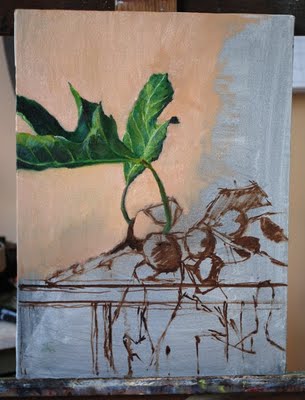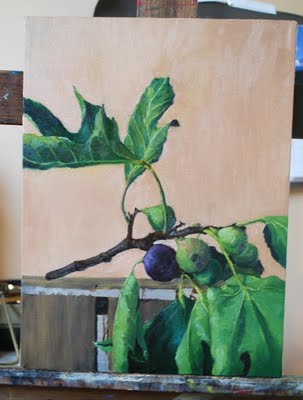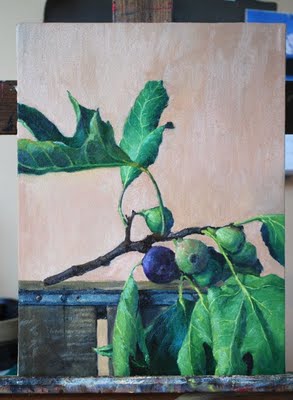Workshop with Danni Dawson
Hello ~
It has been an amazing and busy week. Monday was the first day of the five-day workshop with Danni Dawson. I was so excited about attending this class, excited about what I would learn, excited about what Danni would demonstrate and teach, and I was not disappointed!
During the five days I completed one painting and began another. Because we were painting still life items from her garden and most of the flowers were bloomed out, I focused on painting figs, leaves, and pears instead of painting flowers like I anticipated. Danni suggested that if you have a desire to become a still life artist it is important to plant what will be your subject matter. Something I will keep in mind once we get a house.
This is the first painting I worked on and was lucky enough to finish. It was of a branch of figs and leaves. Figs and leaves have historically been my nemesis where I have scraped down and given up on many a painting before this week.
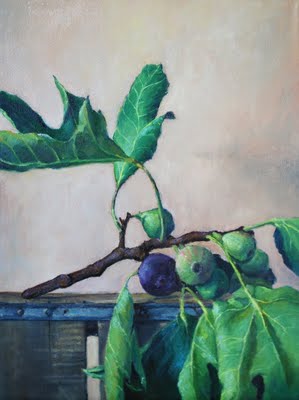 Fig Branch – 16" x 12" (40.6 x 30.5 cm) – Oil on Canvas
Fig Branch – 16" x 12" (40.6 x 30.5 cm) – Oil on Canvas{Day 4 – Final Painting}
One of the first things Danni said on Monday morning was that still life painting requires a lot of planning and forethought on how to go about completing the painting. So when beginning, identify the part that will die/change the fastest. Once this is identified, block in the entire painting but strive to complete that part as quickly as possible. In my case it was the two leaves that were floating above the branch, by the next day they had curled up and fallen down.
On the second day I focused on the figs and the lower leaves, as I saw they had already changed significantly from the day before. Because the wood crate and background were not going to change any, I just blocked in the basic local color values.
The third day was spent refining different parts of the painting, adding highlights, adding further details to the leaves, and finishing up the wooden crate. The one thing I heard over and over again from Danni to me and my classmates was to “slow down”. She was always encouraging us to slow down and truly absorb what we saw. She also encouraged that we break down a particularly complex object into separate areas, and to just paint and complete the individual areas before moving onto another area. She said this was particularly important when painting highly reflective areas like a silver cup. Though one should never just dive into a specific area and finish it until after the whole painting is blocked in and the direction of the painting is clear.
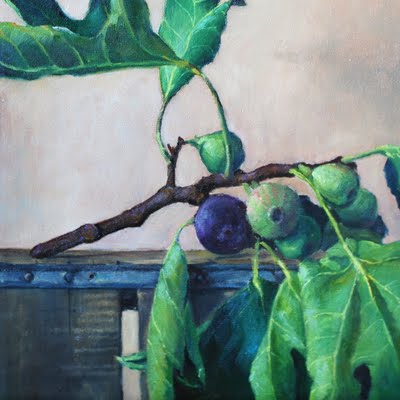
I spent most of the fourth day working on the background. To give it a sense of space, instead of it being a flat single colored surface. I worked with a variety of glazes and solid paint. I also selected areas of the leaves to bright up with transparent orange, an new color for me.
During the week I was exposed to a lot of information, I learned a lot, and know it will take awhile to incorporate everything into my working knowledge. Though the biggest thing I came to understand was the importance of which whites to use and keep on the palette. Over the summer I had started to shy away from using Old Holland Cremnitz White because for awhile it was over $30.00 a tube and I would go through it pretty fast. So I began to use WN Titanium White more and more because it was closer to $20.00 a tube. This looks good initially on the basic economic terms, however over the week Danni demonstrated all these wet in wet techniques that required the lower layer of paint to set up some, becoming a little stiff while still being wet and malleable. This can only be done with a stiff white like Cremnitz or Flake White. So I learned in order to speed up my painting I needed to ditch the slow drying/setting up Titanium White at times and use a lead white. So the expense of the Old Holland Cremnitz White has just proven itself as being a valuable player. (I have tried using the WN Cremnitz White before but it is too gooey and stringy like warm taffy for my liking)
Have a great weekend and once the second painting is finished I will post it.
Liz

